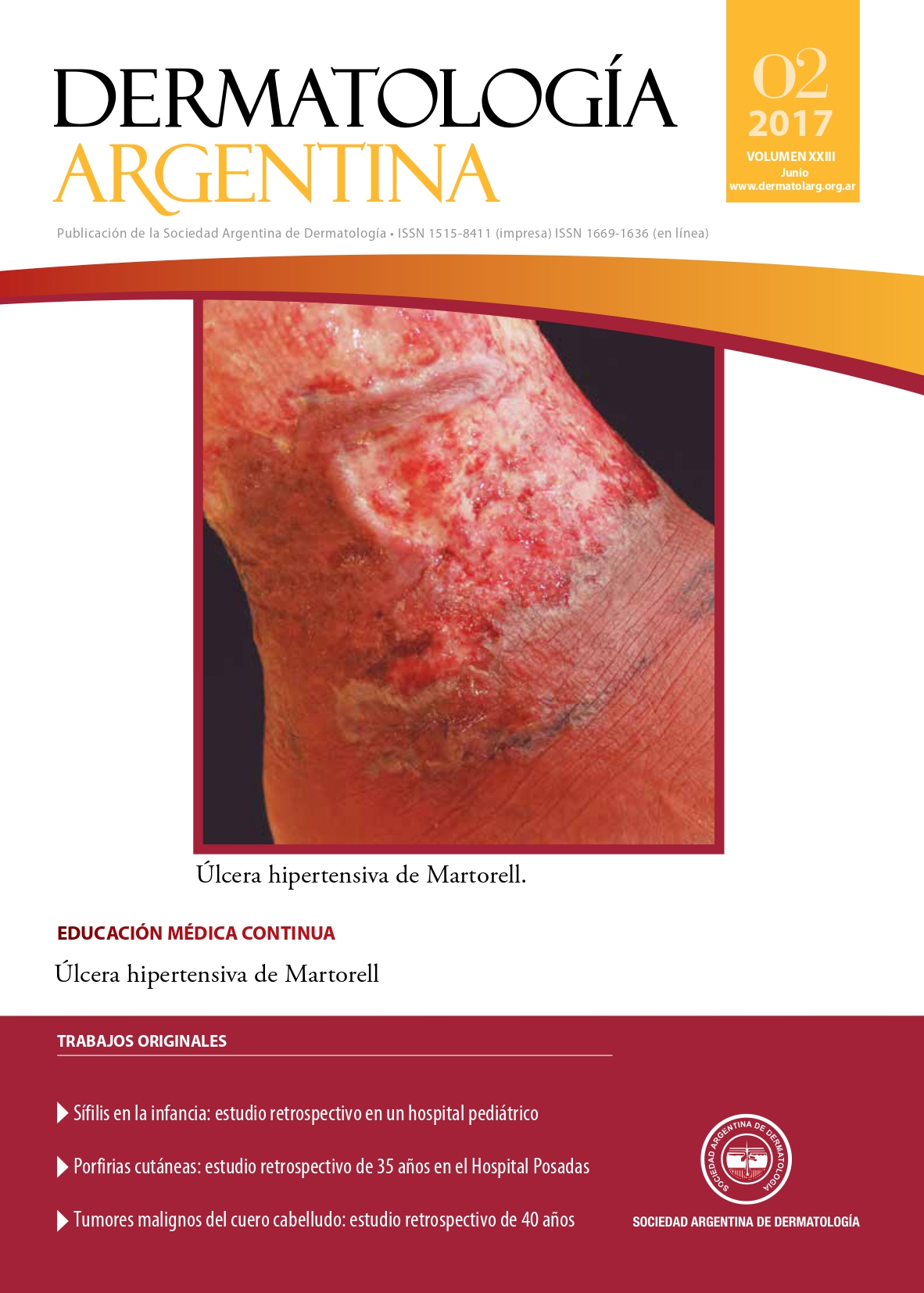Syphilis in childhood: a retrospective study in a pediatric hospital
Keywords:
childhood, acquired syphilis, congenital syphilisAbstract
Syphilis is a preventable infectious disease caused by the Treponema pallidum. It is transmitted by sexual activity, transplacentally or during childbirth. In the last decade, there has been an increase in cases of primary and secondary syphilis worldwide, without there existing any official data of the disease acquired during infancy. A descriptive, retrospective, observational and cross-sectional study of 68 patients with diagnosis and treatment of syphilis in our hospital was carried out from January 2011 to December 2015. According to the mode of transmission, 40% were cases of congenital syphilis and 60% acquired syphilis. Among the patients with acquired syphilis, 17% were found to have been sexually abused. Within the most common cutaneous manifestation in congenital syphilis was the palmo-plantar desquamation (30%) and condylomata (87%) in acquired syphilis. As for systemic manifestations, in congenital syphilis long bones have been affected (48%) and lymphadenopathy (61%) in acquired secondary syphilis. All patients were treated with penicillin according to national consensus. Follow-up was lost in 56% of patients. In conclusion, cases of acquired syphilis are more common within our facilities. Our work highlights the flaws that exist in the healthcare system, such us pre and postnatal screening and the sexual education of the population.
References
I. Forero Laguado N, Peña García MJ. Enfoque global de la sífilis congénita. Med Uis 2011;24:201-215.
II. Woods CR. Syphilis in children: congenital and acquired. Semin Pediatr Infect Dis 2005;16:245-257.
III. World Health Organization, Global incidence and preva-lence of selected sexually transmitted infections 2008. En: http://www.who.int/reproductivehealth/publications/rtis/stisestimates/en; consultado el 28 de agosto de 2016.
IV. Cohen SE, Klausner JD, Engelman J, Philip S. Syphilis in the modern era: an update for physicians. Infect Dis Clin NorthAm 2013;27:705-722.
V. Organización Panamericana de la Salud. Eliminación de la transmisión maternoinfantil del VIH y la sífilis en las Amé-ricas. Actualización 2015. En: http://iris.paho.org/xmlui/handle/123456789/18373; consultado el 27 de agosto de 2016.
VI. Ministerio de Salud Presidencia de la Nación. Boletín integra-do de vigilancia 322–SE32–Agosto de 2016. En: http://www.msal.gob.ar/index.php/home/boletin-integrado-de-vigilan-cia, consultado el 27 de agosto de 2016.
VII. Herremans T, Kortbeek J, Notermans DW. A review of diagnos-tic tests for congenital syphilis in newborns. Eur J Clin Microbiol Infect Dis 2010;29:495-501.
VIII. Mattei PL, Beachkofsky TM, Gilson RT, Wisco OJ. Syphilis: a ree-merging infection. Am Fam Physician 2012; 86:433-440.
IX. Bermejo A, Leiro V. Sífilis. El desafío permanente. Dermatol. Ar-gent 2011;17:156-159.
X. Comisión de SIDA y ETS de la Sociedad Argentina de In-fectología. Primer consenso de diagnóstico, tratamiento y prevención de las enfermedades de transmisión sexual. En: http://www.sadi.org.ar/recomendaciones-y-consensos/item/49-primer-consenso-de-diagnostico-tratamiento-y-pre-vencion-de-las-enfermedades-de-transmision-sexual; consul-tado el 22 de septiembre de 2016.
XI. Balagula Y, Mattei PL, Wisco OJ, Erdag G, et ál. The great imi-tator revisited: the spectrum of atypical cutaneous manifesta-tions of secondary syphilis. Int J Dermatol 2014;53:1434-1441.
XII. Long FQ, Wang QQ, Jiang J, Zhang JP, et ál. Acquired secondary syphilis in preschool children by nonsexual close contact. Sex Transm Dis 2012;39:588-590.
XIII. Centers for Disease Control and Prevention. Congenital syphi-lis. En: http://www.cdc.gov/std/tg2015/congenital.htm; con-sultado el 28 de agosto de 2016.
XIV. Phiske MM. Current trends in congenital syphilis. Indian J Sex Transm Dis 2014;35:12-20.
Downloads
Published
Issue
Section
License
Copyright (c) 2017 Argentine Society of Dermatology

This work is licensed under a Creative Commons Attribution-NonCommercial-NoDerivatives 4.0 International License.
El/los autor/es tranfieren todos los derechos de autor del manuscrito arriba mencionado a Dermatología Argentina en el caso de que el trabajo sea publicado. El/los autor/es declaran que el artículo es original, que no infringe ningún derecho de propiedad intelectual u otros derechos de terceros, que no se encuentra bajo consideración de otra revista y que no ha sido previamente publicado.
Le solicitamos haga click aquí para imprimir, firmar y enviar por correo postal la transferencia de los derechos de autor











